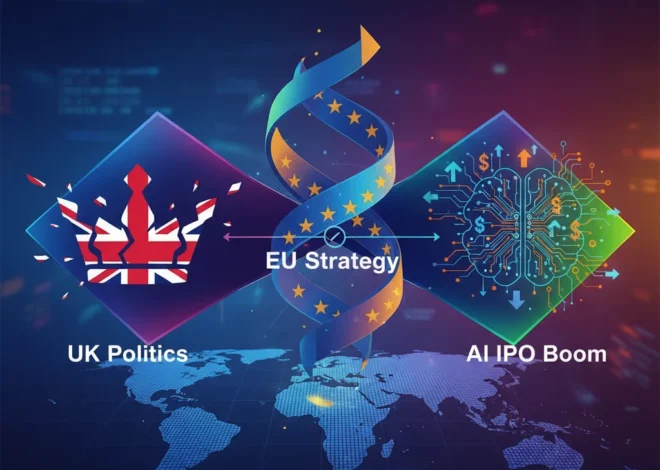
Caught in the Crossfire: Europe’s High-Stakes Gamble in the Global Chip War
The Tiny Chip at the Heart of a Global Power Struggle
In the world of global economics and high finance, sometimes the smallest components cause the biggest shockwaves. Recently, the Dutch government made a decisive move, blocking the Chinese-owned company Nexperia from acquiring Nowi, a Dutch startup specializing in energy-efficient semiconductor technology. On the surface, it’s a minor transaction. But look closer, and you’ll see a stark illustration of a continent caught in the geopolitical crossfire. This single decision reveals the tangled web Europe must navigate in the escalating US-China technology cold war, a conflict that has profound implications for the global economy, the stock market, and long-term investing strategies.
Semiconductors, or chips, are the bedrock of our modern world. They power everything from iPhones and electric vehicles to the vast data centers that run the global banking system and cutting-edge financial technology. They are, without exaggeration, the “new oil” of the 21st century. Control the supply of advanced chips, and you control the future of technology, military power, and economic dominance. The United States understands this. China understands this. The critical question is: Does Europe?
The Nexperia case suggests a continent waking up to the danger, but perhaps too late and without a clear plan. Europe finds itself in an unenviable position—economically dependent on China, its largest trading partner, yet strategically and militarily aligned with the United States. As Washington and Beijing draw their technological battle lines, Europe is being forced to choose a side. Its current strategy, a hesitant mix of protectionism and open-market ideals, risks achieving the worst of both worlds: alienating China while failing to build true technological sovereignty. For business leaders and investors, this uncertainty creates a volatile landscape where supply chain security is no longer a given and geopolitical risk is a primary portfolio concern.
A Dutch Dilemma: The Nexperia Saga Explained
To understand Europe’s predicament, we must first dissect the Nexperia deal. Nexperia, a major manufacturer of basic semiconductors, is headquartered in the Netherlands but has been owned by the Chinese tech company Wingtech since 2019. Its target, Nowi, developed a clever chip that harvests energy from ambient sources like light and radio waves, potentially eliminating the need for batteries in small devices—a key technology for the “Internet of Things” (IoT).
The Dutch government vetoed the takeover on national security grounds, fearing that this valuable intellectual property could fall into the hands of the Chinese state, with potential military applications. This move is part of a broader, US-led effort to restrict China’s access to advanced semiconductor technology. Washington has implemented sweeping export controls and has been pressuring allies, particularly the Netherlands and Japan, to follow suit. The Netherlands is a crucial player because it is home to ASML, the only company in the world capable of producing the extreme ultraviolet (EUV) lithography machines necessary to manufacture the most advanced chips.
The decision to block the deal, however, wasn’t simple. Nexperia is a significant employer in the Netherlands and a vital part of the European semiconductor ecosystem. The move signals a major policy shift for a continent that has long championed free trade. It highlights the central conflict facing European policymakers: how to protect national security without dismantling the globalized supply chains that have fueled its prosperity. This single event is a microcosm of the painful economic decoupling that is reshaping global trading and investment flows.
The EU Chips Act: A Bold Plan with Critical Flaws
In response to these mounting pressures, the EU has launched its flagship initiative: the European Chips Act. This €43 billion plan aims to double the EU’s share of the global semiconductor market to 20% by 2030, bolstering its technological sovereignty and reducing its reliance on vulnerable supply chains, primarily in Taiwan and South Korea.
The ambition is commendable, but the execution raises serious questions. Critics point out several key weaknesses in the EU’s approach:
- Focus on Legacy Chips: A significant portion of the subsidies appears to be directed towards manufacturing older, less advanced “legacy” chips. While these are essential for industries like automotive, this strategy does little to close the gap with the US and Asia in cutting-edge logic chips—the brains behind AI, supercomputing, and advanced financial technology.
- Insufficient Funding: While €43 billion sounds substantial, it is spread across 27 member states and pales in comparison to the resources being mobilized by its competitors. The US CHIPS Act provides $52 billion in direct subsidies, and China is estimated to be investing well over $150 billion in its domestic industry.
- Risk of Fragmentation: Instead of fostering a unified European strategy, the Chips Act could trigger a subsidy race between member states, each vying to attract fabs (semiconductor fabrication plants) from giants like Intel and TSMC. This could lead to inefficient capital allocation and fail to create a cohesive, world-leading ecosystem.
Here’s a simplified comparison of the major global initiatives, highlighting the scale of the challenge Europe faces:
| Region/Country | Key Initiative | Estimated Public & Private Investment | Primary Goal |
|---|---|---|---|
| United States | CHIPS and Science Act | ~$280 Billion (including $52B in direct subsidies) | Onshore advanced manufacturing, boost R&D, and counter China. |
| European Union | EU Chips Act | €43 Billion | Double market share to 20% by 2030, focusing on both legacy and advanced chips. |
| China | National Integrated Circuit Plan (“Big Fund”) | $150+ Billion | Achieve complete self-sufficiency across the entire semiconductor supply chain. |
| South Korea | K-Belt Strategy | ~$450 Billion (mostly private, with gov’t incentives) | Solidify its global leadership in memory and foundry services. |
As the table shows, Europe’s financial commitment, while significant, is part of a much larger global race. The continent’s strategy seems defensive rather than offensive, aimed more at plugging gaps than at creating a dominant position in the next generation of technology.
What This Means for Investors and the Global Economy
For those involved in finance and investing, this geopolitical turmoil in the semiconductor industry is a critical variable. The era of frictionless global supply chains is over, replaced by a landscape defined by “friend-shoring,” protectionism, and technological bifurcation. This new reality presents both significant risks and unique opportunities.
The Risks:
- Supply Chain Volatility: Companies heavily reliant on cross-border supply chains (e.g., European car manufacturers dependent on Asian chips) face increased disruption risk and higher costs. This can directly impact corporate earnings and stock market performance.
- Market Access for European Tech: Premier European tech firms like ASML, Infineon, and STMicroelectronics face a precarious balancing act. China is a massive market for them, but acceding to US pressure could cut them off from a major source of revenue. This regulatory risk is now a core part of their investment thesis.
- Inflationary Pressures: Duplicating supply chains is expensive. The cost of building new, localized fabs will inevitably be passed on to consumers, potentially fueling inflation and complicating the work of central banking authorities.
The Opportunities:
- Semiconductor Equipment & Design: Companies that provide the foundational tools and intellectual property for chipmaking, like ASML (lithography) and ARM (chip design), may benefit regardless of where the fabs are built. They are the “picks and shovels” in this technological gold rush.
- Onshoring Beneficiaries: Businesses involved in the construction, equipping, and servicing of new semiconductor plants in Europe and the US stand to gain from the massive government subsidies being deployed.
- Specialized Niche Players: As the EU funnels money into specific areas, smaller companies specializing in fields like compound semiconductors, chip design software, or advanced packaging could become attractive acquisition targets or breakout stars. This is where deep-due diligence in the economics of the industry can pay off.
Ultimately, the chip war is accelerating the fragmentation of the global economy. Investors must now think like geopolitical strategists, analyzing not just a company’s balance sheet but also its position on the new map of technological alliances and rivalries. The stability of our interconnected financial world, from high-frequency trading algorithms to the complex systems underpinning blockchain technology, all rely on a predictable supply of these tiny, powerful components.
Crafting a Winning Strategy: Europe’s Path Forward
Europe is at a crossroads, and its current path appears fraught with peril. A more effective strategy would not be to simply copy the US or try to build a completely self-sufficient “Fortress Europe.” Instead, it should play to its unique strengths.
First, Europe must double down on its crown jewel: ASML. The continent should build a protective ecosystem around ASML, investing heavily in the R&D, materials science, and specialized engineering that support its dominance. Second, rather than splurging on costly advanced manufacturing fabs it is unlikely to master, Europe could focus on its existing strengths in chip design, automotive and industrial semiconductors, and advanced research. The IMEC research hub in Belgium is a world leader and a model to build upon.
Finally, a truly “European” approach requires unity. A fragmented, nation-by-nation subsidy war will only weaken the bloc’s position. A coordinated, pan-European strategy that pools resources, identifies areas of collective strength, and speaks with one voice on the global stage is the only credible path to achieving genuine strategic autonomy.
The seizure of Nexperia was a wake-up call. It’s a clear signal that the old rules of globalization no longer apply. For European leaders, the challenge is to craft a new rulebook—one that secures the continent’s technological future without isolating its economy. For investors, the challenge is to understand and navigate this complex new world, where a single microchip can define the macro-economic landscape for decades to come.


